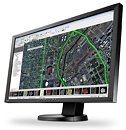- Joined
- Oct 9, 2007
- Messages
- 47,669 (7.43/day)
- Location
- Dublin, Ireland
| System Name | RBMK-1000 |
|---|---|
| Processor | AMD Ryzen 7 5700G |
| Motherboard | Gigabyte B550 AORUS Elite V2 |
| Cooling | DeepCool Gammax L240 V2 |
| Memory | 2x 16GB DDR4-3200 |
| Video Card(s) | Galax RTX 4070 Ti EX |
| Storage | Samsung 990 1TB |
| Display(s) | BenQ 1440p 60 Hz 27-inch |
| Case | Corsair Carbide 100R |
| Audio Device(s) | ASUS SupremeFX S1220A |
| Power Supply | Cooler Master MWE Gold 650W |
| Mouse | ASUS ROG Strix Impact |
| Keyboard | Gamdias Hermes E2 |
| Software | Windows 11 Pro |
EIZO Corporation today announced the DuraVision FDF2405W, a 23.5-inch color LCD monitor for displaying satellite images. The DuraVision FDF2405W reduces image lag with its 240 Hz blur reduction function. The monitor converts 120 Hz input signals to 240 Hz, doubling the number of frames for sharper, highly visible images with reduced motion blur that is caused by frame changes. This greatly contributes to eliminating eye fatigue that occurs when viewing scrolling or moving images.
The DuraVision FDF2405W also comes equipped with EIZO's patented drift correction circuit that stabilizes the screen brightness level within minutes after startup or from returning from power save mode. In addition, EIZO's Digital Uniformity Equalizer (DUE) technology improves picture quality by counteracting fluctuations in brightness and chromaticity across the screen.

A 3D LUT is used to adjust colors individually on an RGB cubic table. This improves the monitor's additive color mixture, a key factor in its ability to display neutral gray tones displayed in satellite images.
The DuraVision FDF2405W supports EPD (Equal Probability of Detection) gamma, defined by the United States National Geospatial Intelligence Agency. With it, the monitor displays subtle variations in tones more clearly in undefined areas of satellite images and aerial photos. The EPD preset mode ensures that each gradient step between black and white can be detected and defines objects and details in images that would otherwise be difficult to see.
The 3-pin mini-DIN connector equipped in the DuraVision FDF2405W generates a sync signal with 120 Hz input so the monitor can display 3D images using an active shutter 3D system. The FDF2405W has a wide viewing angle of 176° so users experience minimal color shift when viewing the monitor from an angle. In addition, the high contrast ratio of 5000:1 combined with the maximum brightness of 350 cd/m² maintains excellent screen visibility where details are essential. The non-glare panel also dissipates reflective light for high readability, even in bright ambient conditions.
Additional Features
View at TechPowerUp Main Site
The DuraVision FDF2405W also comes equipped with EIZO's patented drift correction circuit that stabilizes the screen brightness level within minutes after startup or from returning from power save mode. In addition, EIZO's Digital Uniformity Equalizer (DUE) technology improves picture quality by counteracting fluctuations in brightness and chromaticity across the screen.

A 3D LUT is used to adjust colors individually on an RGB cubic table. This improves the monitor's additive color mixture, a key factor in its ability to display neutral gray tones displayed in satellite images.
The DuraVision FDF2405W supports EPD (Equal Probability of Detection) gamma, defined by the United States National Geospatial Intelligence Agency. With it, the monitor displays subtle variations in tones more clearly in undefined areas of satellite images and aerial photos. The EPD preset mode ensures that each gradient step between black and white can be detected and defines objects and details in images that would otherwise be difficult to see.
The 3-pin mini-DIN connector equipped in the DuraVision FDF2405W generates a sync signal with 120 Hz input so the monitor can display 3D images using an active shutter 3D system. The FDF2405W has a wide viewing angle of 176° so users experience minimal color shift when viewing the monitor from an angle. In addition, the high contrast ratio of 5000:1 combined with the maximum brightness of 350 cd/m² maintains excellent screen visibility where details are essential. The non-glare panel also dissipates reflective light for high readability, even in bright ambient conditions.
Additional Features
- Stand with wide height adjustment range, tilt, and swivel
- Portrait mode capability
- USB hub with one upstream and two downstream ports
- Quiet fanless operation
- Equipped with energy-saving LED backlight
- Backed by a 2-year, 24-hour continuous use warranty
View at TechPowerUp Main Site







